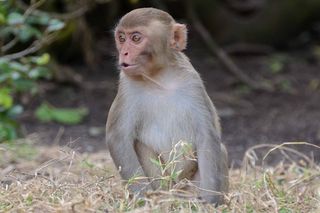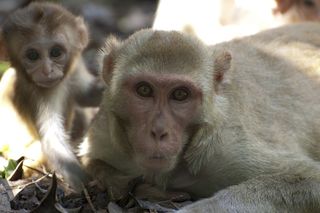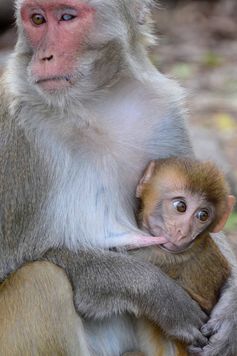
Monkeys Recognize Family, Even if Separated at Birth (Op-Ed)

This article was originally published at The Conversation. The publication contributed the article to Live Science's Expert Voices: Op-Ed & Insights.
Macaque monkeys grow up with their mothers and are often not familiar with their fathers. But they can recognise the paternal side of the family even without ever being introduced to them, according to a study published in the journal Current Biology. The researchers suggest that just looking at another monkey is enough to know whether they are related.
“There is some evidence that non-human primates can recognise facial resemblances between two other individuals, just like us,” Dana Pfefferle, lead author and post-doctoral researcher at Duke University, said. “We found that the macaques could detect their own relatives without being familiar with members of that side of the family.”
Polygamy is a common theme in the rhesus macaque world. A female macaque mates with multiple males at the same time, making it difficult to identify the father of the child. Males are also known to change their social groups often, picking different partners in different groups. A child may grow up having never met anyone from the father’s side of its family. Being raised by its mother, the child is mainly surrounded by its maternal relatives.
Pfefferle and her colleagues were studying rhesus macaques living freely on Cayo Santiago, a small island about a kilometre off the south-east coast of Puerto Rico. The island is run and maintained by the Caribbean Primate Research Centre and the University of Puerto Rico, Medical Sciences Campus.

The monkeys of the island have been studied in their wild habitat for more than 70 years. This is why Pfefferle could be confident about their pedigree tree and be confident that the relationship of each monkey to the others had accurately been mapped. During Pfefferle ’s work there, she noticed that some monkeys could recognise their paternal half-siblings and interact with them even without being part of the same group. This was intriguing.
To understand what was prompting this recognition, Pfefferle decided to run an experiment. She showed the monkeys facial pictures of two unfamiliar monkeys – one of them their paternal half-sibling and the other unrelated. If both the monkeys shown were of the same gender as the participants, then the participants spent more time staring at the unrelated monkey.
Sign up for the Live Science daily newsletter now
Get the world’s most fascinating discoveries delivered straight to your inbox.
Seeing the pictures of unknown monkeys of the same sex ought to make the participant feel threatened, which would make them spend more time staring at them. So this indicated that the monkeys could make out their half-siblings and spent relatively less time staring at them.
When shown pictures of two monkeys of the opposite gender, however, the participants made no distinction between related or unrelated monkeys. Pfefferle thinks that seeing females brought on mating instincts in males, even if they were related. In the case of females, who also spent the same amount of time looking at the pictures of related and unrelated males, the explanation may be more complex.

Female macaques invest a lot in their babies, starting from pregnancy through to bringing up their young ones. They want to prevent inbreeding and so they prefer to find unrelated males as mates. This should mean that they would evolve the ability to differentiate between related and unrelated males.
But macaque society has a gender bias. Males are ranked higher and could be a threat to them. So when shown pictures of a male, a female could be conflicted between choosing new mates by differentiating between unrelated and related males and keeping an eye out for males just looking for trouble. This causes them to spend equal time staring at images of related and unrelated males.
These kind of studies are usually performed on monkeys kept in captivity. The Cayo monkeys which participated in the study lived by themselves on an uninhabited island. These were untrained monkeys, but they had become habituated with humans – mostly scientists and administrators – and were friendly towards them.
“They were very keen in participating in these visual experiments,” Pfefferle said. “One female kept following us just to have another glance at the pictures.”
It is remarkable that the monkeys were able not only to identify paternal facial features but also compare them with the images they were shown. Pfefferle and her team have found that beyond recognising faces, the monkeys use other cues like identifying their paternal half-siblings' calls. “It would be interesting to see how a combination of different cues could affect the monkeys' ability to recognise paternal kins,” Pfefferle said.
Anwesha Ghosh does not work for, consult to, own shares in or receive funding from any company or organisation that would benefit from this article, and has no relevant affiliations.
This article was originally published on The Conversation. Read the original article. Follow all of the Expert Voices issues and debates — and become part of the discussion — on Facebook, Twitter and Google +. The views expressed are those of the author and do not necessarily reflect the views of the publisher. This version of the article was originally published on Live Science.
Most Popular


